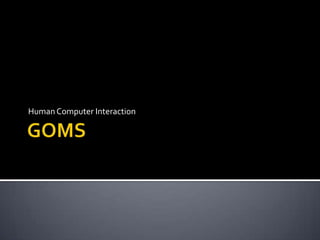
Exploring GOMs
- 2. Developed in 1983 by Stuart Card, Thomas P. Moran and Allen Newell. Explained in their book “The Psychology of Human Computer Interaction”
- 3. Goals - what the user intends to accomplish Operators - are actions that are performed to reach the goal. Methods - are sequences of operators that accomplish a goal. Selections - there can be more than one method available to accomplish a single goal; used to describe when a user would select a certain method over the others.
- 4. These can be very wide reaching; from very high-level goals (e.g. Write a book) to very low-level goals (e.g. Type the word ‘Red’). Higher-level goals can be divided into smaller lower-level goals.
- 5. Operators are the simple actions that are used to accomplish your goals (e.g. ‘Left-click mouse button’ or ‘Press ALT’). Operators cannot break down any further: they are atomic elements (similar to those found in a database). Generally, it’s assumed that each operator requires a fixed quantity of time to perform the action and this time interval is independent of context. For example, to double left click a mouse button takes 0.40 seconds of execution time, regardless of what you happen to be clicking on.
- 6. Methods are procedures that describe how to accomplish goals. A method is essentially the steps a user has to take to complete a specified task. For instance, one method to accomplish the goal ‘Highlight Word’ in a Windows text editor would be to ‘move cursor’ to the beginning of the word and ‘hold shift and right arrow key’. Another method to accomplish the same goal could involve ‘holding down the left mouse button’ and ‘dragging to the beginning of the word’.
- 7. Selection rules specify which method is best to use when completing a goal, based on the given context. Since there could be several ways of achieving the same result, a selection rule utilises the user's knowledge of the best method to achieve the required goal. Selection rules generally take the form of a conditional statement, such as “IF the word to highlight is less than five characters USE the arrow keys and shift ELSE the mouse dragging method".
- 8. Quantitatively, GOMS offer good predictive models of performance time and learning. For example, when choosing between two systems you can apply a GOMS model. Application 1 has a lower start-up costs, but will be slower to perform frequent tasks; Application 2 will be faster to perform tasks, but has a longer learning time, etc. With these quantitative predictions, you can examine such tradeoffs in the light of what is important to your company. Qualitatively, GOMS can be used to design training programs and help systems. This approach has been shown to be an efficient way to organise help systems, tutorials, and training programs as well as user documentation.
- 9. ‘Natural GOMS Language’ allows a more flexible representation of a task using ‘human’ language: Method for goal: Deleting Icon Step 1. Select Icon For Deletion (1.10 sec) Step 2. Drag Icon To Trashcan (1.10 sec) Step 3. Update User with audio cue (0.22 sec) This NGOMSL model predicts that it will take 2.42 seconds to delete an icon.
- 10. The model assumes a certain level of skill – it cannot accurately be applied to beginners. The model doesn’t take into account time for learning the system or remembering how to use it after a long period of disuse; for example, can you remember where all the options are in Windows 98? The model removes human error from the equation; even highly skilled users make the occasional mistake! Mental workload is not addressed in the model; it’s far more taxing when remembering a longer process than a short one. E.g. It’s a far less stressful task to highlight text than entering network settings manually. Users can get tired; you’re not going to be as quick typing after three hours as you were when you started! Differences among users is not accounted for within the model – e.g. Those who are left handed aren’t given special preference. Predicting whether a system will be functional or acceptable for users is not included in the model. E.g. Just because workers can enter data quickly into a new database system, it doesn’t mean it’s particularly ‘user friendly’ and ‘easy to work with’. How computer-assisted technology integrates into everyday business is not addressed in the model. For example, entering commands using a keyboard could be the quickest method of data capture for astronauts, however, trying to type in ‘zero gravity’ may be difficult.